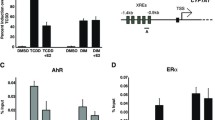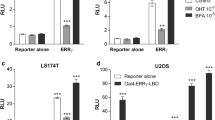Abstract
The estrogen-related receptor alpha (ERRα, NR3B1) is an orphan nuclear receptor which plays a role in endocrine disruption, energy homeostasis, and cancer prognosis. One of the unique features of this transcription factor is the interplay with its cofactors. For instance, certain modulators require the presence of proliferator-activated receptor gamma coactivator 1 alpha (PGC-1α) alongside ERRα. Therefore, identification of ERRα agonists and antagonists require examination of this nuclear receptor alone and together with PGC-1α. In this book chapter, we describe the step-by-step protocol of a multiplex luciferase assay designed to identify ERRα agonists, antagonists, and toxicity in one quantitative high-throughput screening assay using two different stable cell lines.
Access this chapter
Tax calculation will be finalised at checkout
Purchases are for personal use only
Similar content being viewed by others
References
Huss JM, Imahashi KI, Dufour CR, Weinheimer CJ, Courtois M, Kovacs A, Giguere V, Murphy E, Kelly DP (2007) The nuclear receptor ERR alpha is required for the bioenergetic and functional adaptation to cardiac pressure overload. Cell Metab 6(1):25–37. https://doi.org/10.1016/j.cmet.2007.06.005
Tripathi M, Yen PM, Singh BK (2020) Estrogen-related receptor alpha: an under-appreciated potential target for the treatment of metabolic diseases. Int J Mol Sci 21(5):1645. https://doi.org/10.3390/ijms21051645
Giguere V, Yang N, Segui P, Evans RM (1988) Identification of a new class of steroid-hormone receptors. Nature 331(6151):91–94. https://doi.org/10.1038/331091a0
Giguere V (2002) To ERR in the estrogen pathway. Trends Endocrinol Metab 13(5):220–225. https://doi.org/10.1016/s1043-2760(02)00592-1
Liu D, Zhang Z, Gladwell W, Teng CT (2003) Estrogen stimulates estrogen-related receptor alpha gene expression through conserved hormone response elements. Endocrinology 144(11):4894–4904. https://doi.org/10.1210/en.2003-0432
Ariazi EA, Clark GM, Mertz JE (2002) Estrogen-related receptor alpha and estrogen-related receptor gamma associate with unfavorable and favorable biomarkers, respectively, in human breast cancer. Cancer Res 62(22):6510–6518
Ariazi EA, Kraus RJ, Farrell ML, Jordan VC, Mertz JE (2007) Estrogen-related receptor alpha1 transcriptional activities are regulated in part via the ErbB2/HER2 signaling pathway. Mol Cancer Res 5(1):71–85. https://doi.org/10.1158/1541-7786.MCR-06-0227
Deblois G, Hall JA, Perry MC, Laganiere J, Ghahremani M, Park M, Hallett M, Giguere V (2009) Genome-wide identification of direct target genes implicates estrogen-related receptor alpha as a determinant of breast cancer heterogeneity. Cancer Res 69(15):6149–6157. https://doi.org/10.1158/0008-5472.CAN-09-1251
Arany Z, Foo SY, Ma Y, Ruas JL, Bommi-Reddy A, Girnun G, Cooper M, Laznik D, Chinsomboon J, Rangwala SM, Baek KH, Rosenzweig A, Spiegelman BM (2008) HIF-independent regulation of VEGF and angiogenesis by the transcriptional coactivator PGC-1alpha. Nature 451(7181):1008–1012. https://doi.org/10.1038/nature06613
Deblois G (1812) Giguere V (2011) functional and physiological genomics of estrogen-related receptors (ERRs) in health and disease. Biochim Biophys Acta 8:1032–1040. https://doi.org/10.1016/j.bbadis.2010.12.009
Kamei Y, Ohizumi H, Fujitani Y, Nemoto T, Tanaka T, Takahashi N, Kawada T, Miyoshi M, Ezaki O, Kakizuka A (2003) PPARgamma coactivator 1beta/ERR ligand 1 is an ERR protein ligand, whose expression induces a high-energy expenditure and antagonizes obesity. Proc Natl Acad Sci U S A 100(21):12378–12383. https://doi.org/10.1073/pnas.2135217100
Schreiber SN, Knutti D, Brogli K, Uhlmann T, Kralli A (2003) The transcriptional coactivator PGC-1 regulates the expression and activity of the orphan nuclear receptor estrogen-related receptor alpha (ERRalpha). J Biol Chem 278(11):9013–9018. https://doi.org/10.1074/jbc.M212923200
Luo J, Sladek R, Carrier J, Bader JA, Richard D, Giguere V (2003) Reduced fat mass in mice lacking orphan nuclear receptor estrogen-related receptor alpha. Mol Cell Biol 23(22):7947–7956. https://doi.org/10.1128/mcb.23.22.7947-7956.2003
Leone TC, Lehman JJ, Finck BN, Schaeffer PJ, Wende AR, Boudina S, Courtois M, Wozniak DF, Sambandam N, Bernal-Mizrachi C, Chen Z, Holloszy JO, Medeiros DM, Schmidt RE, Saffitz JE, Abel ED, Semenkovich CF, Kelly DP (2005) PGC-1alpha deficiency causes multi-system energy metabolic derangements: muscle dysfunction, abnormal weight control and hepatic steatosis. PLoS Biol 3(4):e101. https://doi.org/10.1371/journal.pbio.0030101
Teng CT, Beames B, Alex Merrick B, Martin N, Romeo C, Jetten AM (2014) Development of a stable cell line with an intact PGC-1alpha/ERRalpha axis for screening environmental chemicals. Biochem Biophys Res Commun 444(2):177–181. https://doi.org/10.1016/j.bbrc.2014.01.033
Teng CT, Hsieh JH, Zhao J, Huang R, **a M, Martin N, Gao X, Dixon D, Auerbach SS, Witt KL, Merrick BA (2017) Development of novel cell lines for high-throughput screening to detect estrogen-related receptor alpha modulators. SLAS Discov 22(6):720–731. https://doi.org/10.1177/2472555216689772
Lynch C, Zhao J, Huang R, Kanaya N, Bernal L, Hsieh JH, Auerbach SS, Witt KL, Merrick BA, Chen S, Teng CT, **a M (2018) Identification of estrogen-related receptor alpha agonists in the Tox21 compound library. Endocrinology 159(2):744–753. https://doi.org/10.1210/en.2017-00658
Lynch C, Zhao J, Sakamuru S, Zhang L, Huang R, Witt KL, Merrick BA, Teng CT, **a M (2019) Identification of compounds that inhibit estrogen-related receptor alpha signaling using high-throughput screening assays. Molecules 24(5):841. https://doi.org/10.3390/molecules24050841
Acknowledgments
This work was supported in part by the Intramural research program of the NCATS, NIH.
Author information
Authors and Affiliations
Corresponding author
Editor information
Editors and Affiliations
Rights and permissions
Copyright information
© 2022 This is a U.S. government work and not under copyright protection in the U.S.; foreign copyright protection may apply
About this protocol
Cite this protocol
Lynch, C., Zhao, J., **a, M. (2022). Cell-Based Assays to Identify ERR and ERR/PGC Modulators. In: Zhu, H., **a, M. (eds) High-Throughput Screening Assays in Toxicology. Methods in Molecular Biology, vol 2474. Humana, New York, NY. https://doi.org/10.1007/978-1-0716-2213-1_1
Download citation
DOI: https://doi.org/10.1007/978-1-0716-2213-1_1
Published:
Publisher Name: Humana, New York, NY
Print ISBN: 978-1-0716-2212-4
Online ISBN: 978-1-0716-2213-1
eBook Packages: Springer Protocols




